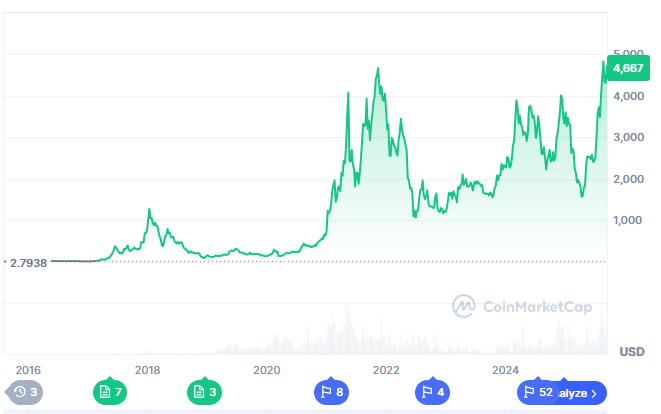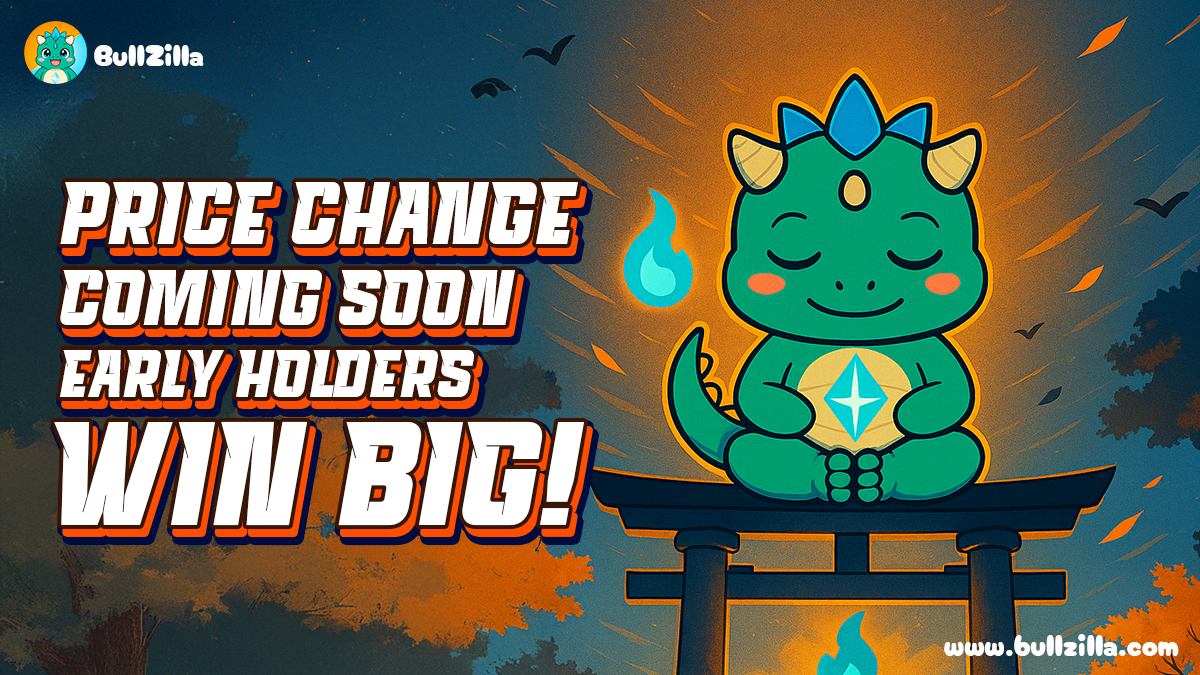Ethereum remains the world’s second-largest blockchain, securing over $1 trillion in value and hosting thousands of applications across DeFi, NFTs, and DAOs. Yet beneath the glossy valuation lies a paradox: Ethereum’s developers, the very backbone of the network, remain dramatically underpaid compared to their peers in other industries.
Recent reports reveal a troubling mismatch, while external offers for blockchain developers soar to $300,000–$700,000, the median Ethereum developer salary stands around $140,000. This tension creates both retention risks and a possible brain drain just as Ethereum’s role in global finance expands.
Alongside Ethereum’s paradoxical fundamentals, retail energy continues to flow into presales. BullZilla ($BZIL), one of the most talked-about projects of 2025, has already sold 24.7 billion tokens, raised over $400,000, and drawn 1,400+ holders. It represents the high-risk, high-reward retail counterpoint to Ethereum’s institutional narrative.
Ethereum’s Developer Paradox
The Ethereum blockchain’s strength is undeniable: it secures trillions, powers millions of wallets, and underpins thousands of apps. Yet Protocol Guild data shows its developers earn significantly less than industry standards. Most receive no equity or tokens, only 37% enjoy token allocations versus a 6.5% average elsewhere.
This raises serious concerns about Ethereum’s long-term sustainability. If top talent exists for higher pay, the network’s pace of innovation, upgrade reliability, and neutrality could weaken. Protocol Guild has distributed $33 million since 2022 to retain contributors, but much more may be required to balance Ethereum’s trillion-dollar stature with fair developer compensation.
Ethereum Open Interest Surges Past $10B
Beyond the pay gap, Ethereum’s derivatives market tells a bullish story. Open interest recently crossed $10 billion, driven primarily by institutional long positions. This signals confidence as ETH eyes a move toward $5,000.
It is typical of the high open interest to be more liquid and participatory; however, it may increase volatility. Institutions create credibility, but the leveraged strategies might result in even more intense corrections. For DAOs and retail investors, this environment demands robust risk management and treasury diversification.
Ethereum Foundation Pushes Privacy Roadmap
Another critical update is Ethereum’s pivot toward privacy. On September 12, the Ethereum Foundation rebranded its Privacy & Scaling Explorations team as Privacy Stewards of Ethereum (PSE), signaling a shift from theory to practice.
The roadmap aims to ensure Ethereum doesn’t evolve into a surveillance tool but remains a platform for freedom. As Sam Richards of PSE emphasized, Ethereum must enable users to transact and prove information without exposing their identities, an essential step for global adoption.
Ethereum in Digital Asset Treasuries
Ethereum is also emerging as a treasury asset among publicly traded firms. Data shows 11 companies now hold 3.43M ETH worth over $15.2 billion. Bitmine Immersion leads with 2M+ ETH, while SharpLink follows with 837K ETH.
This mirrors Bitcoin’s earlier trajectory, where corporate treasuries like Strategy (formerly MicroStrategy) gained prominence by stacking BTC. Ethereum’s growing role in balance sheets signals that institutions increasingly see it as a core, long-term digital asset.
BullZilla Presale Achieves Key Milestones
While Ethereum captures institutional attention, BullZilla ($BZIL) thrives on retail energy. The project is currently in Stage 2, “Dead Wallets Don’t Lie”, priced at $0.00005241. It has raised over $400,000, sold 24.7 billion tokens, and drawn more than 1,400 holders.
BullZilla’s presale uses a progressive pricing model that raises token costs every $100K or every 48 hours, ensuring built-in scarcity. Early investors are already seeing gains of 811%, with ROI projections nearing 9,958% by the listing price of $0.00527. Combined with staking up to 70% APY and referral bonuses, BullZilla is making its mark as the best crypto presale in 2025.
Latest BullZilla Snapshot
| Metric | Status |
| Stage | 2nd – “Dead Wallets Don’t Lie” |
| Phase | 4th |
| Price | $0.00005241 |
| Raised | $400K+ |
| Holders | 1,400+ |
| Tokens Sold | 24.7B |
| ROI to Listing | 9,958% |
| ROI Early Joiners | 811.47% |
| Next Price | +12.72% to $0.00005908 |
Conclusion: Ethereum and BullZilla Shape 2025
Ethereum sits at the crossroads of paradox and progress. A trillion-dollar blockchain with underpaid developers, rising institutional demand, and a renewed focus on privacy, it remains indispensable to the crypto ecosystem. Yet, the pay gap poses risks that must be addressed if Ethereum is to sustain its dominance.
Meanwhile, Bull Zilla epitomizes the speculative fervor of retail investors. As a high-risk, high-reward counterpart to the institutional path of Ethereum, it has a potential ROI of nearly 10,000% and can rapidly grow its pre-sale. Ethereum and BullZilla are examples of the two forces of 2025: institutional adoption and retail speculation.
For More Information:
Follow BZIL on X (Formerly Twitter)
Frequently Asked Questions About Ethereum and BullZilla
Why are Ethereum developers underpaid?
Despite Ethereum’s $1T valuation, median salaries are around $140K, far below competing offers.
What does $10B open interest mean for Ethereum Price?
It shows rising institutional participation, potentially driving ETH toward $5,000 but with added volatility.
What is Ethereum doing to combat the issue of privacy?
It can be done through the Privacy Stewards of Ethereum (PSE) program that concentrates on practical privacy remedies.
Why are treasuries accumulating Ethereum?
Firms see ETH as a long-term asset, with 11 companies holding $15.2B worth.
What stage is BullZilla’s presale in?
Stage 2 (Dead Wallets Don’t Lie), priced at $0.00005241.
What ROI potential does BullZilla offer?
Up to 9,958% by listing, with early joiners already sitting on 811% gains.
Why is BullZilla called the best crypto presale in 2025?
Its progressive pricing, high staking APY, and referral bonuses set it apart.
Disclaimer: This media platform provides the content of this article on an "as-is" basis, without any warranties or representations of any kind, express or implied. We assume no responsibility for any inaccuracies, errors, or omissions. We do not assume any responsibility or liability for the accuracy, content, images, videos, licenses, completeness, legality, or reliability of the information presented herein. Any concerns, complaints, or copyright issues related to this article should be directed to the content provider mentioned above.








